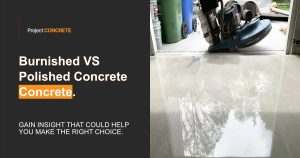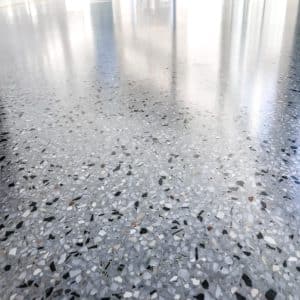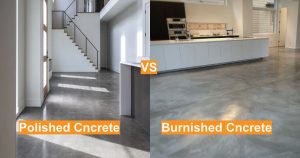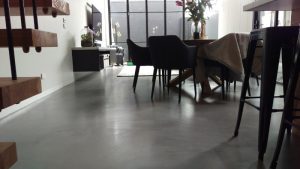
Concrete flooring has evolved from a basic, utilitarian choice to a sophisticated and versatile option for both residential and commercial spaces. Two popular finishes that often come up in discussions uneven floor name are burnished and polished concrete. While they may appear similar at first glance, there are significant differences between the two in terms of the process, aesthetics, and performance. In this comprehensive guide, we will explore the key distinctions between burnished and polished concrete, helping you make an informed decision for your flooring needs.

Understanding Burnished Concrete
Burnishing concrete involves a finishing technique that enhances the surface’s appearance and durability without removing any material. The process begins soon after the concrete is poured. A power trowel, also known as a burnisher, is used to smooth the surface by trowelling it with heat, until it achieves a glossy sheen. This is typically done within the first few hours of pouring the concrete while it is still uncured. To further enhance the finish, a high-speed burnishing machine equipped with diamond-impregnated pads can be used to heat, melt, and buff a chemical coating into the surface, filling the pores of the concrete and providing a satin-like sheen.
To understand burnished concrete further please read – A Guide To Burnished Concrete Floors
Application of Coating
A crucial part of burnishing is the application of a wax-based coating or a topical sealer. This chemical coating fills the pores of the concrete, enhancing its durability and giving it a reflective, polished look. The coating is heated and buffed into the surface using a high-speed burnishing machine, which helps to create a smooth, glossy finish.
For more information please read – How To Do Burnished Concrete in 11 Steps
Benefits of Burnished Concrete
Burnished concrete offers several advantages. It is a cost-effective flooring solution that is easier to achieve compared to polished concrete. The burnished finish enhances the floor’s durability, making it resistant to wear and tear. Additionally, the glossy surface of burnished floor reflects light, which can brighten up any space. This makes burnished concrete an excellent choice for commercial and industrial settings where durability and low maintenance are crucial.

Understanding Polished Concrete
The Polishing Process
Polished concrete, on the other hand, involves a more intensive and detailed process. It starts with the curing of the concrete, which typically takes about one to two days. Once the concrete is fully cured, the surface honed concrete is polished using heavy-duty machines equipped with diamond-segmented abrasives. These machines grind down the surface of the concrete to achieve the desired level of smoothness and gloss.
Use of Densifiers
During the concrete polishing up process, a chemical densifier is applied to the concrete surface. The densifier penetrates the concrete, increasing its hardness and density. This step is essential as it prepares the surface for further grinding and polishing, enhancing its durability and resistance to stains and damage.
Benefits of Polished Concrete
Polished, concrete floor, is known for its high-gloss finish that can be customised to different levels of sheen and aggregate exposure. It is a highly durable flooring option that can withstand heavy foot traffic and industrial use. The polished surface is also easy to maintain, as it resists stains and spills. Moreover, polished concrete floors are hypoallergenic and do not harbour dust or allergens, making them ideal for residential spaces as well.

Key Differences Between Burnished and Polished Concrete
Process and Technique
The most significant difference between burnished and polished concrete lies in the process and technique used to achieve the finish. Burnishing is a quicker and simpler process that involves trowelling decorative concrete and applying a topical sealer shortly after the concrete is poured. Polishing, however, is a multi-step process that requires curing the concrete, grinding it down with diamond abrasives, and applying a densifier before achieving the final polished finish.
Aesthetic Appeal
While both finishes result in a polished concrete offers a glossy surface, the aesthetic appeal can vary. Burnished concrete has a more natural look, with a smoother and more compacted upper layer. It may show slight variations in colour and texture, which can add character to the floor. Polished concrete, on the other hand, offers a more uniform and highly reflective finish. The level of sheen and aggregate exposure can be customised, providing a more tailored look.
Durability and Performance
In terms of durability and performance, polished concrete generally has an edge over burnished concrete. The use of a densifier in the polishing process increases the hardness and strength of the polishing concrete’ surface, making it more resistant to damage and wear. Polished concrete is also less prone to scratches and stains compared to burnished concrete, which relies more on the protective coating for durability.
Maintenance
Both burnished and polished concrete floors are low-maintenance options, but there are some differences in their upkeep. Burnished concrete requires regular reapplication of the topical sealer to maintain its glossy appearance and protective qualities. Polished concrete, however, retains its shine and durability with minimal maintenance. Regular sweeping and occasional mopping are usually sufficient to keep burnished floors polished concrete floors looking their best.

Choosing the Right Finish for Your Space
Residential Spaces
For residential spaces, both a burnished concrete finish and polished concrete can be excellent choices. Burnished concrete offers a cost-effective solution with a natural and glossy finish that can enhance the aesthetic appeal of living rooms, kitchens, and hallways. Polished concrete, with its high-gloss and hypoallergenic properties, is ideal for areas where a sleek, modern look is desired, and ease of maintenance is a priority.
Commercial and Industrial Spaces
In commercial and industrial settings, durability and low maintenance are paramount. Polished concrete is often the preferred choice due to its ability to withstand heavy foot traffic and its resistance to stains and damage. The reflective surface of a polished concrete floor can also improve lighting efficiency in large spaces like warehouses and retail stores. Burnished concrete is also a viable option, particularly in spaces where a more natural look is desired, and budget constraints are a consideration.
Offices
Both burnished and polished concrete can transform office spaces into stylish and functional environments. Polished concrete provides a finished floor with a high-end, professional look that can impress clients and create a positive atmosphere for employees. Burnished concrete offers a more relaxed and rustic appeal, which can be perfect for creative workspaces and open-plan offices.
Environmental Impact
Both burnished and polished concrete are environmentally friendly flooring options. They make use of the existing concrete slab, reducing the need for additional materials and minimising waste. Polished concrete has the added benefit of reducing energy consumption due to its reflective surface, which can improve natural lighting and decrease the need for artificial lighting. Burnished and polished concrete finish, with its simpler process, also has a lower carbon footprint compared to other flooring options that require extensive material use and transportation.
Conclusion
Understanding the differences between burnished and polished concrete is crucial for selecting the right concrete finish used for your space. While both options offer a glossy and durable surface, they differ significantly in terms of process, aesthetics, and performance. Burnished concrete is a cost-effective and natural-looking option, suitable for various residential and commercial applications. Polished concrete, with its high-gloss finish and superior durability, is ideal for high-traffic areas and modern interiors.
By considering the unique characteristics and benefits of each finish, you can make an informed decision that meets your aesthetic preferences, functional needs, and budget constraints. Whether you choose burnished or polished concrete, you can enjoy a beautiful, durable, and low-maintenance floor that enhances the overall appeal of your space.
